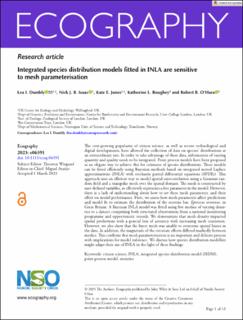| dc.description.abstract | The ever-growing popularity of citizen science, as well as recent technological and digital developments, have allowed the collection of data on species' distributions at an extraordinary rate. In order to take advantage of these data, information of varying quantity and quality needs to be integrated. Point process models have been proposed as an elegant way to achieve this for estimates of species distributions. These models can be fitted efficiently using Bayesian methods based on integrated nested Laplace approximations (INLA) with stochastic partial differential equations (SPDEs). This approach uses an efficient way to model spatial autocorrelation using a Gaussian random field and a triangular mesh over the spatial domain. The mesh is constructed by user-defined variables, so effectively represents a free parameter in the model. However, there is a lack of understanding about how to set these mesh parameters, and their effect on model performance. Here, we assess how mesh parameters affect predictions and model fit to estimate the distribution of the serotine bat, Eptesicus serotinus, in Great Britain. A Bayesian INLA model was fitted using five meshes of varying densities to a dataset comprising both structured observations from a national monitoring programme and opportunistic records. We demonstrate that mesh density impacted spatial predictions with a general loss of accuracy with increasing mesh coarseness. However, we also show that the finest mesh was unable to overcome spatial biases in the data. In addition, the magnitude of the covariate effects differed markedly between meshes. This confirms that mesh parameterisation is an important and delicate process with implications for model inference. We discuss how species distribution modellers might adapt their use of INLA in the light of these findings. | en_US |

